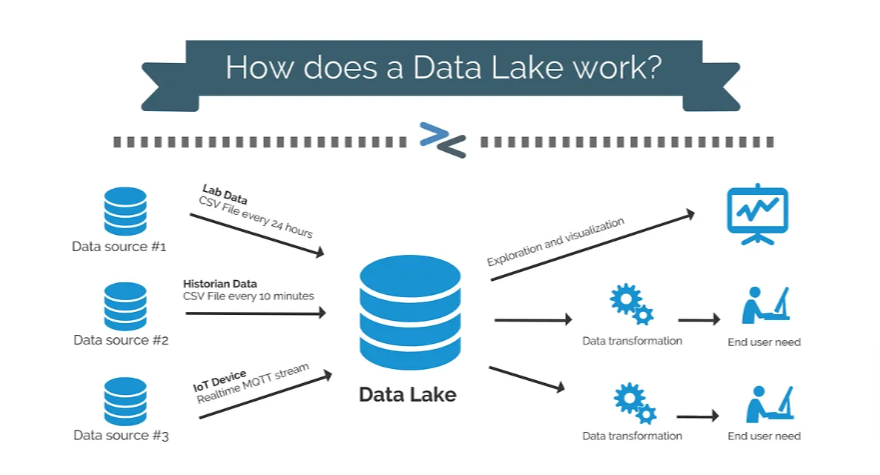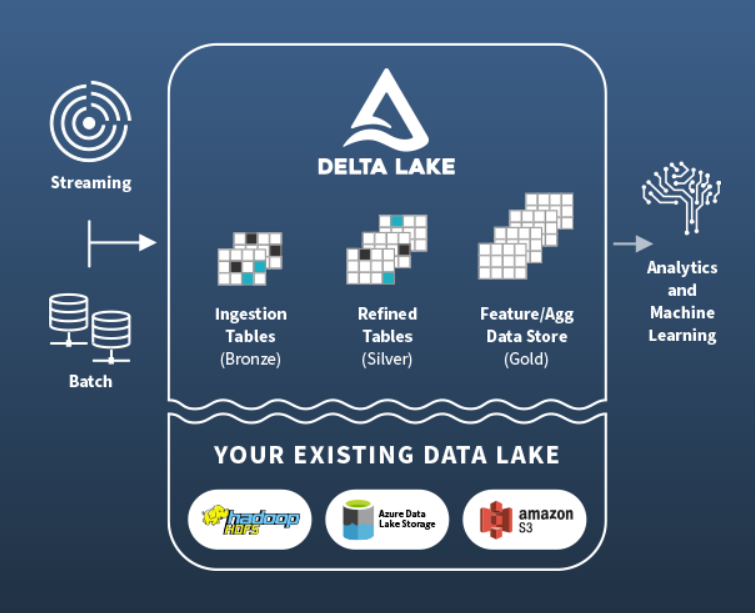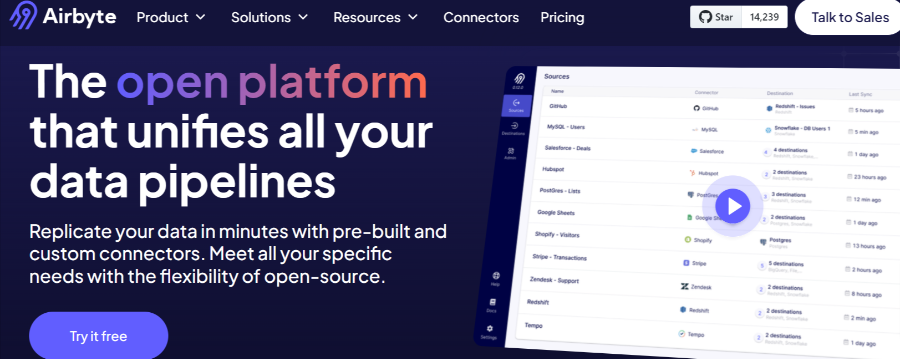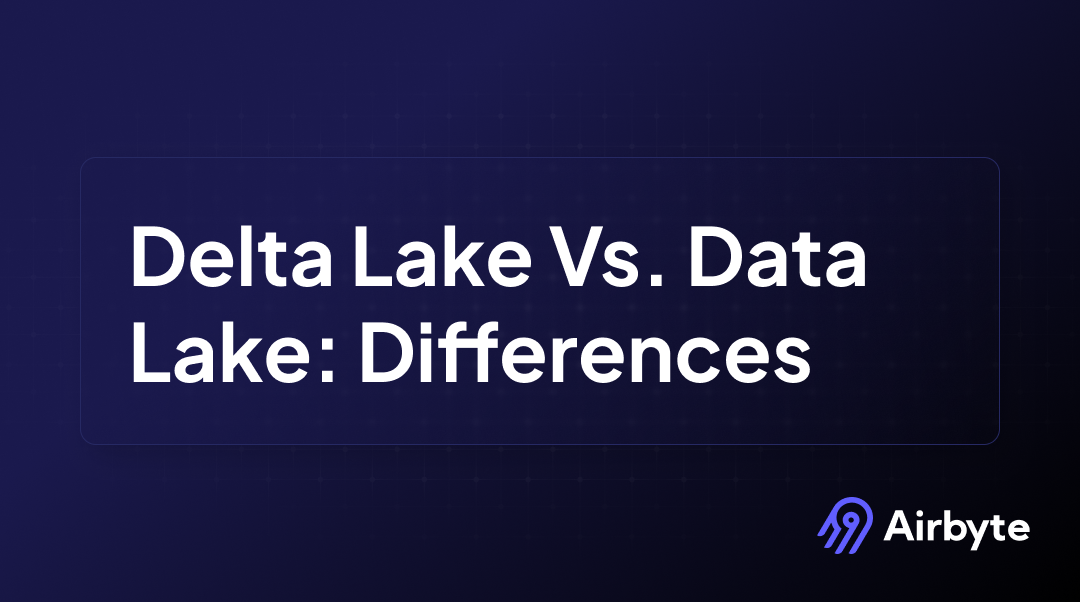Delta Lake Vs. Data Lake: Key Differences
Summarize this article with:
✨ AI Generated Summary
Delta Lake enhances traditional Data Lakes by adding ACID transactions, schema enforcement, versioning, and time-travel capabilities, addressing challenges like data consistency, governance, and performance. Key innovations in Delta Lake 4.0 include coordinated commits for multi-cloud support, advanced data type handling, and improved reliability features, making it ideal for complex, real-time analytics and concurrent workloads. Data Lakes remain suitable for cost-effective, flexible storage and batch processing, while Delta Lake offers a more structured, reliable foundation for mission-critical and high-concurrency environments.
Data Lakes have become essential in modern data infrastructure, offering a centralized solution for storing extensive volumes and varieties of data. Despite this flexibility, managing and processing data in a Data Lake can present significant challenges, such as data consistency and governance.
Delta Lake is a robust solution designed to address the challenges commonly encountered in traditional Data Lakes.
This article explores the key differences between Delta Lake and Data Lake, focusing on their strengths and use cases while examining the latest innovations that make Delta Lake an increasingly compelling choice for modern data architectures.
What Are the Core Characteristics of a Data Lake?

A Data Lake is a centralized storage repository that can hold vast amounts of structured (databases), semi-structured (JSON, XML), and unstructured (text files, images, sensor readings) data. This flexibility allows you to store all your data in its native form, regardless of current use case or analytical needs.
Key attributes of a Data Lake
- Scalability: Data Lakes efficiently handle massive, growing datasets through horizontal scaling. This capability becomes increasingly important as organizations generate exponentially more data from IoT devices, social media platforms, and business applications.
- Cost-effectiveness: Storing data in its native format eliminates the need for immediate transformation and reduces preparation costs. Organizations can defer transformation decisions until specific analytical requirements emerge, avoiding premature optimization costs.
- Collaboration and data sharing: Authorized users across teams can access diverse datasets stored within the lake. Cross-functional teams can discover and leverage data assets that might otherwise remain siloed in departmental systems, fostering innovation and comprehensive analytical insights.
Challenges associated with Data Lakes
- Schema enforcement challenges: Lack of schema enforcement can complicate data organization, retrieval, and analysis. Without predefined structures, data quality issues accumulate over time, creating what industry professionals often call "data swamps." These situations require significant remediation efforts and can undermine confidence in analytical outcomes.
- Governance complexity: Governing vast amounts of data presents complex challenges around ownership, access control, and data-quality standards. Organizations struggle to maintain visibility into data lineage, implement consistent security policies, and ensure compliance with regulatory requirements across diverse data sources and formats.
- Processing overhead: Processing raw data for specific purposes often requires additional tools, increasing compute costs and processing time. The schema-on-read approach, while flexible, can result in repeated parsing and validation overhead that impacts performance and resource utilization.
What Defines Delta Lake and Its Advanced Capabilities?

Delta Lake is a modern storage and management layer built on top of a Data Lake that enhances data management and analytics by offering a reliable single source of truth for all data workloads. Delta Lake can handle petabytes of data and protect sensitive information with robust isolation and serialization capabilities.
Key attributes of a Delta Lake
- Time-Travel functionality: Utilizes a comprehensive transaction log that records every change, allowing you to query or roll back to any previous version for historical analysis, audits, or troubleshooting.
- Data Manipulation Language (DML) support: Provides native capabilities for UPDATE, MERGE, DELETE, and other operations that simplify common data-management tasks.
- Schema enforcement: Validates data types on write, maintaining consistency and reliability across all data operations. This validation prevents schema drift and ensures that downstream applications can rely on consistent data structures.
What Are the Latest Delta Lake 4.0 Innovations That Transform Data Management?
Delta Lake 4.0 represents a significant leap forward in data lake technology, introducing revolutionary features that address longstanding challenges in distributed data management.
Coordinated Commits and Multi-Cloud Architecture
Coordinated commits in Delta Lake 4.0 enable multi-cloud and multi-engine writes without relying on filesystem-level coordination. This advancement eliminates bottlenecks in distributed systems and ensures atomicity across diverse storage environments, including AWS S3, Azure Blob Storage, and Google Cloud Platform. Organizations can now maintain consistent data states across multiple cloud providers while avoiding vendor lock-in situations that constrain long-term technology evolution.
Advanced Data Type Support and Schema Evolution
The introduction of the VARIANT type in Delta Lake 4.0 revolutionizes handling of semi-structured data such as JSON and Avro formats. This enhancement enables flexible schema evolution and high-performance processing for nested data types, addressing growing demands for handling dynamic IoT sensor data and event streaming information. The VARIANT type optimizes storage and processing compared to traditional string-based JSON storage methods.
Performance and Reliability Enhancements
Version checksums provide integrity assurance for each commit, verifying table state consistency during transactions and detecting inconsistencies in distributed environments. This feature accelerates query initialization by bypassing initial protocol checks while ensuring data reliability across complex multi-node deployments.
Row tracking capabilities enable detailed lineage and traceability at the individual record level, supporting compliance requirements such as GDPR "right to be forgotten" mandates. This granular tracking facilitates audit processes and enables precise data governance across large-scale analytical environments.
How Do Modern Architectural Patterns Enhance Data Lake and Delta Lake Implementations?
Contemporary data architecture strategies emphasize composable, event-driven patterns that maximize flexibility while maintaining governance and performance standards. These approaches represent a fundamental shift from monolithic data platforms toward modular, best-of-breed solutions that adapt to evolving business requirements.
Data Mesh and Federated Governance Strategies
Data mesh architectures distribute data ownership to domain-specific teams while maintaining unified governance standards through federated computational approaches. This methodology addresses scalability challenges in centralized data organizations by embedding governance into domain teams rather than relying on bottlenecked central authorities. Each domain maintains responsibility for data quality, schema evolution, and access patterns while adhering to organization-wide security and compliance policies.
Composable Architecture and Real-Time Integration
Composable data platforms enable direct querying of data in-place without duplication, avoiding traditional extract-transform-load overhead while maintaining single sources of truth. These architectures leverage cloud-native compute resources to process data where it resides, eliminating costly data movement and reducing time-to-insight for analytical workloads.
Event-driven architectures complement composable designs by enabling real-time data synchronization through change data capture and streaming platforms such as Apache Kafka. This combination supports near-instant analytical updates while maintaining consistency across distributed systems.
What Are the Key Differences Between Delta Lake and Traditional Data Lakes?
Delta Lake adds ACID transactions, schema enforcement, and versioning to a Data Lake, making it more reliable and structured for analytics, whereas a traditional Data Lake simply stores raw, unstructured data at scale.
Architecture
Delta Lake
- Delta table architecture utilizes columnar storage formats that improve query performance and compression efficiency.
- Delta log functionality captures all changes to data tables, enabling comprehensive versioning and rollback capabilities.
- Storage layer integration with underlying object storage systems such as Amazon S3 and Azure Data Lake Storage provides a scalable, cost-effective foundation.
Data Lake
- Ingestion layer components collect and import data from multiple sources, including databases, APIs, file systems, and streaming platforms.
- Distillation layer processes clean, normalize, aggregate, and enrich raw data into structured forms suitable for analysis.
- Processing layer provides computational engines for queries and analytics, typically requiring separate tools and platforms optimized for different workload types.
Schema validation
- Data Lake implementations follow flexible approaches that enable quick ingestion of diverse data types without predefined schemas. This flexibility accelerates data onboarding but creates risks of data-quality issues and downstream processing complications when schema expectations change.
- Delta Lake enforces schema validation on write operations, rejecting data that violates defined table schemas and ensuring integrity across all data operations. This approach prevents schema drift and maintains consistency for downstream analytical applications.
ACID transactions
- Data Lake architectures lack built-in mechanisms for consistency during concurrent write operations, creating risks of data corruption and incomplete updates during high-concurrency scenarios. Organizations must implement external coordination mechanisms to ensure data integrity.
- Delta Lake guarantees atomicity, consistency, isolation, and durability through its transaction log mechanism, preventing corruption and ensuring reliable concurrent access patterns. These guarantees enable complex analytical workloads with confidence in data consistency.
Performance optimization
- Delta Lake implementations leverage Apache Spark's distributed processing capabilities to accelerate workloads through parallel execution and advanced optimization techniques. Built-in features such as liquid clustering and data skipping significantly improve query performance without requiring external tools.
- Data Lake performance improvements typically require external tools or manual techniques such as partitioning strategies, file size optimization, and index creation. These approaches add complexity and maintenance overhead while providing less integrated optimization benefits.
Versioning & time travel
- Data Lake environments lack native versioning capabilities, requiring manual processes such as creating data copies that increase storage costs and management complexity. Historical analysis requires maintaining separate datasets with associated metadata management challenges.
- Delta Lake transaction logs provide effortless time-travel queries and rollback capabilities without additional storage overhead. Users can query any previous version of data tables or restore to earlier states with simple SQL commands.
When Should You Choose Between Data Lakes and Delta Lake?
Stick with Data Lakes when:
- One-time or periodic batch processing requirements are sufficient for your analytical needs, and real-time capabilities are not essential.
- No concurrent write operations are required in your data processing workflows, eliminating the need for ACID transaction capabilities.
- Pipelines remain simple in structure, and budget constraints require minimizing platform costs.
- Data storage requirements are temporary or experimental in nature, where long-term governance and versioning capabilities provide minimal value.
Delta Lake adds value when:
- Complex, concurrent data operations are essential for your analytical workflows, requiring reliable coordination between multiple writers and readers.
- Real-time or near-real-time processing capabilities are required to support business operations such as fraud detection, recommendation engines, or operational monitoring.
- Multiple teams access or modify the same datasets concurrently, creating coordination challenges that traditional Data Lakes cannot address effectively.
- Performance and reliability are high priorities for mission-critical analytical workloads where data quality issues create significant business risks.
How Can You Successfully Migrate from Data Lake to Delta Lake?
Analyze your existing Data Lake infrastructure by assessing data volumes, query patterns, critical tables, and dependencies across your analytical ecosystem.
Begin with smaller, lower-risk tables that have well-defined schemas and limited downstream dependencies. Convert Parquet files or other formats to Delta format using Apache Spark operations while maintaining parallel operations with existing systems.
Validate and optimize converted datasets by comparing record counts, running key business queries on both old and new systems, and measuring performance characteristics.
Keep original Data Lake systems operational as fallback options until validation confirms successful migration and stakeholder acceptance.
How Does Airbyte Facilitate Data Integration for Central Repositories?
Managing data from disparate sources can be complex and resource-intensive. Airbyte simplifies this challenge by connecting diverse data sources to destinations such as Azure Blob Storage, Amazon S3, Delta Lake, or traditional Data Lake environments through its comprehensive integration platform.

- Extensive connector library: Over 600 pre-built connectors accelerate integration workflows by eliminating custom development overhead for common data sources and destinations.
- Custom connector development: The Connector Development Kit enables organizations to build custom connectors for specialized data sources while following established patterns and best practices.
- Real-time synchronization: Built-in Change Data Capture capabilities keep destinations synchronized with source systems through real-time or incremental replication patterns.
- Transformation integration: Seamless integration with transformation tools such as dbt streamlines data preparation workflows by enabling SQL-based transformations within the same platform ecosystem.
- Enterprise-grade security: Security best practices are embedded throughout Airbyte connectors, including support for SSH tunneling, HTTPS encryption, and SSL certificates.
Conclusion
In summary, Delta Lake represents the next step beyond traditional Data Lakes by combining the scalability and flexibility of raw data storage with built-in reliability, governance, and performance improvements. Its ACID transactions, schema enforcement, and time-travel capabilities make it a strong choice for organizations that need consistent, high-quality data across complex, real-time workloads. While Data Lakes are still valuable for exploratory or cost-sensitive storage, Delta Lake offers a more structured foundation for advanced analytics and AI-driven use cases.
The right choice depends on your operational needs, concurrency requirements, and long-term governance goals, but for modern data-driven businesses, Delta Lake increasingly stands out as the smarter and more future-ready option.
Frequently Asked Questions
What is a Data Lake in simple terms?
A Data Lake is a centralized repository that holds vast amounts of structured, semi-structured, and unstructured data in its native form.
What problems does Delta Lake solve?
Delta Lake addresses data quality, consistency, and transactionality issues commonly found in traditional Data Lakes.
What is the difference between a Data Lake and a data mart?
A data mart is a subject-oriented data store tailored to a specific department (finance, marketing, etc.), whereas a Data Lake houses all of an organization's raw data, regardless of structure or purpose.
Can you store unstructured data in Delta Lake?
Yes. You can store unstructured data such as images or audio in Delta Lake and decode it when needed.

.webp)
